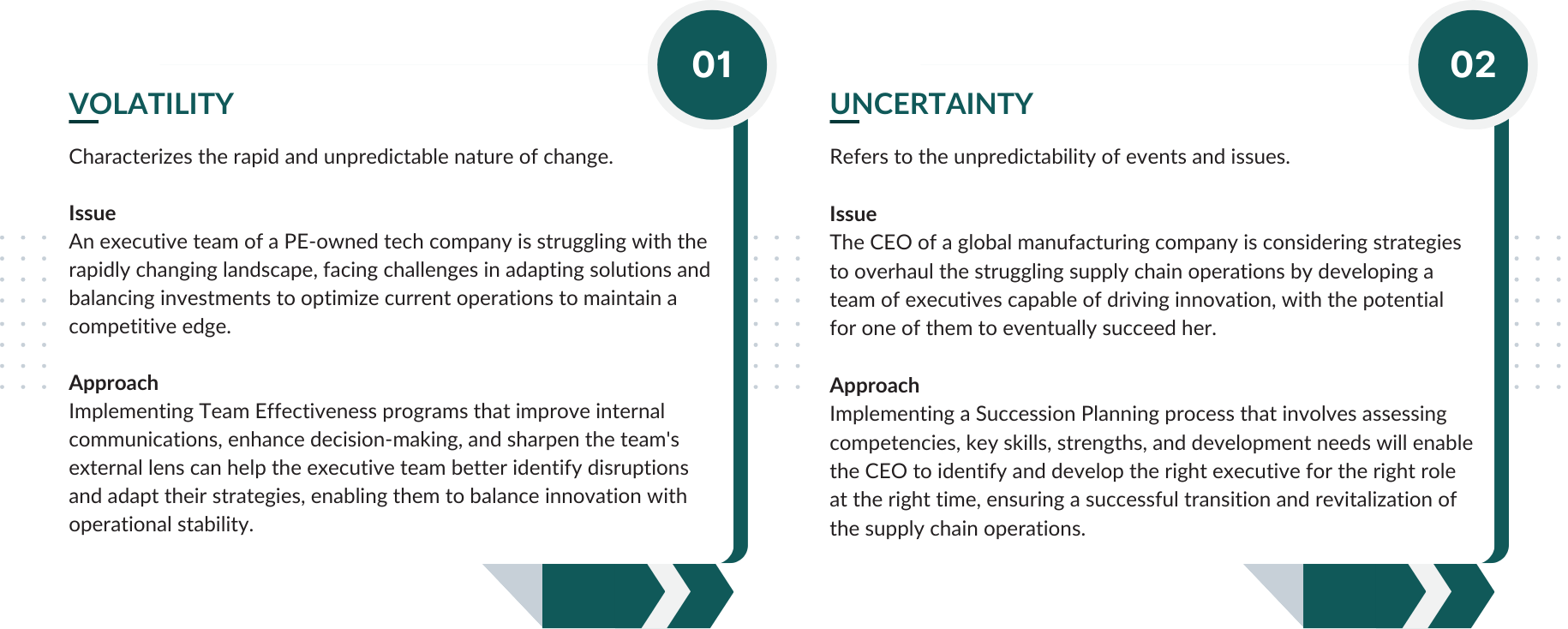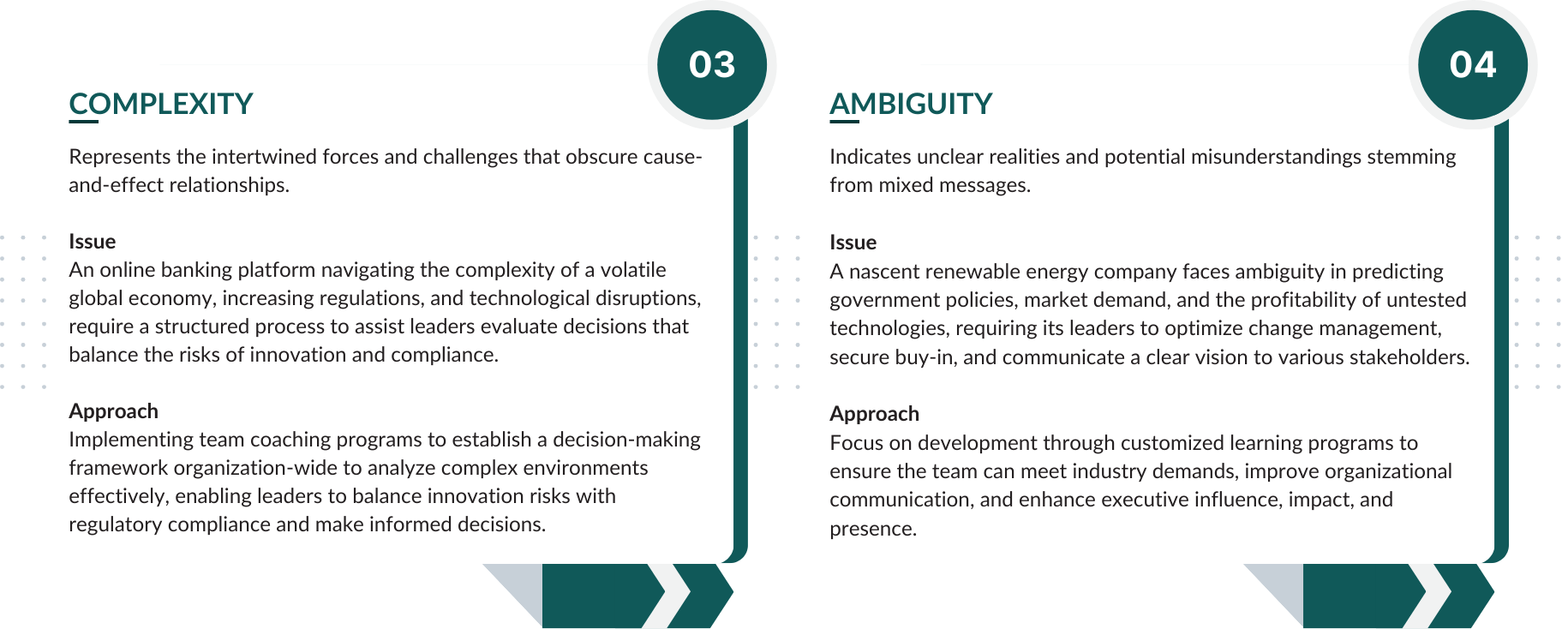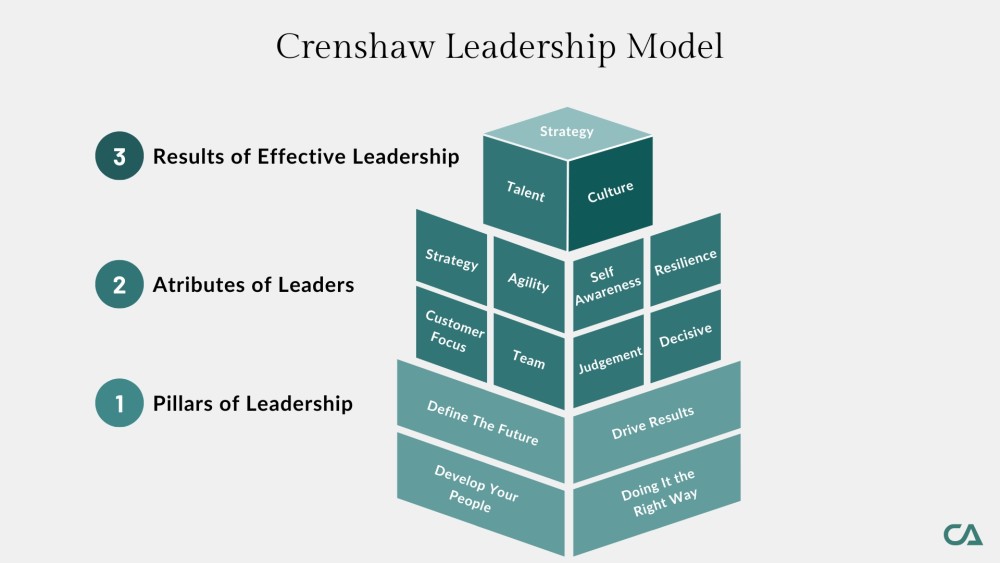Effective Decision-Making in a VUCA Environment

Bill Glenn
Executive Chairman

For the past 40 years, Crenshaw has had a maniacal focus on scaling leadership for executives across various industries and geographies for corporations and PE. The one constant we’ve observed is change—an ever-accelerating pace of disruption that challenges companies to tap into their most valuable resource: their people. The imperative to scale leadership capable of thriving in such dynamic conditions has never been greater.

In my conversations with senior executives, I have identified a crucial shift in perspective necessary for new and the most senior leaders. They must learn to view their environments through the lens of VUCA—an acronym for Volatility, Uncertainty, Complexity, and Ambiguity. We have integrated VUCA principles into our coaching practice to support this shift, providing a decision-making framework that helps leaders adapt to sustainable change and disruption.
Our role as coaches and advisors is to power executives’ skills and mindset to lead and thrive through sustained disruption. In response to this need, we evolved our leadership model to outline the essential characteristics and foundational elements leaders need to navigate the VUCA environment. By employing this framework, we help leaders identify disruptions early, build resilient teams, and maintain the agility and stamina required to succeed amidst continuous upheaval.
This approach not only prepares leaders to face immediate challenges, but also equips them with the tools to foster long-term resilience and adaptability, ensuring their organizations can thrive in an unpredictable world.
Part 1: Understanding VUCA and Its Relevance Today
VUCA—Volatility, Uncertainty, Complexity, Ambiguity—originated as a military term from the U.S. Army War College in the late 1980s to describe the dynamic and rapidly changing world after the end of the Cold War. The idea was to help military leaders make sense of an environment where traditional strategies were no longer sufficient. Over time, we aptly joined in appropriating the term to describe the array of challenges business organizations face today.
In contemporary business practices, VUCA serves as an apt representation of the volatile, uncertain, complex, and ambiguous nature of modern markets. These include disruptive technologies, shifting consumer behaviors, ever-changing regulatory landscapes, and geopolitical disturbances. Firms today must continuously navigate these disruptions to remain relevant and competitive. To that end, adopting a VUCA mindset can offer a strategic advantage.

In fact, even before the wave of AI disruption, in his book Thank You for Being Late, Tom Friedman spoke about how the speed of technology outpaces a human’s abilities to catch up, clearly framing the complexities facing executives and necessitates scaling leadership and a focus on optimizing decision making.
The Evolution of Disruptions: From Episodic to Sustainable
Historically, disruptions in the business environment have been episodic. Economic recessions, geopolitical crises, and natural disasters would disrupt the status quo, but these were generally temporary. Organizations would respond, adapt, and eventually return to some form of normalcy. However, in the past decade, there has been a shift from episodic disruptions to more sustainable and persistent disruptions and change.

Consider emerging technological advancements such as Artificial Intelligence, blockchain, and the Internet of Things. These are not fleeting trends, but paradigm shifts that are redefining industries and the future of work. Similarly, geopolitical shifts and environmental regulations are compounding the complexities businesses must manage. The climate today demands not just adaptive strategies, but a foundational shift in how organizations handle disruptions and succeed. Therefore, VUCA provides a lens to view these ongoing challenges and better strategize for short- and long-term success.
Navigating the VUCA Reality
Given the new nature of sustainable disruptions, it is crucial for business leaders to accurately diagnose and differentiate between episodic and sustainable impacts. Episodic disruptors like economic downturns or sudden political upheaval necessitate immediate response mechanisms. These might involve crisis management tactics, robust contingency plans, and building short-term organizational resilience. While intense and disruptive, these events generally subside, allowing organizations to stabilize.
Conversely, sustainable disruptions—such as the ongoing integration of AI into business processes or the shift toward consumer-centric business models—require continuous adaptation, innovation and clear–eyed strategies. Strategies for dealing with such disruptions often involve larger-scale transformational change: embracing innovation, iterative adaptation, and constantly seeking emerging opportunities. Firms must be agile and forward-thinking in their approach to strategy, operations, and talent management.
Part 2: Optimizing Decision-Making
The VUCA context not only describes our working environment but also fundamentally influences our approach to decision-making. Businesses need a robust framework to navigate the complexity and ambiguity presented by continuous disruptions. At Crenshaw, we’ve outlined a six-point framework and orientation that allows for better decision making designed to help leaders make informed and effective decisions in a VUCA environment.
Optimizing Decision-Making
Grounded in Data Being rooted in data and insights is crucial, but it's also important to avoid the paralysis that can come from over-analyzing data. Decisions need to be data-informed but executed with agility. Data allows leaders to strike a balance between speed and accuracy in which teams can act swiftly on the insights without getting bogged down in excessive deliberation.
Collaborative Conflict Encouraging rigorous debate among skilled team members fosters the best decisions. Often, organizations interpret collaboration as a message to solve issues without disagreement or debate. Creating and modeling a culture where diverse viewpoints are respected but vigorously debated, is critical to strong and sustained business performance. This approach leverages the collective intelligence of the team, ensuring that decisions are well-rounded and thoroughly vetted.
Maintain an External Lens Having an objective view of market dynamics and uncovering non-legacy competitors is essential. It’s the non-legacy competitor that will render your business model obsolete. Understanding external factors and potential disruptors allows businesses to anticipate changes and adapt proactively. This external perspective prevents organizations from being blindsided by new entrants and emerging trends.
Invest in Team Diversity An effective decision-making team reflects the diversity of its stakeholders, encompassing varied perspectives on thought, race, ethnicity, gender, and more. This diversity ensures that different viewpoints are considered, leading to more comprehensive and inclusive decisions. Diverse teams are better equipped to understand and address the multifaceted challenges of a VUCA environment.
Team Internal Density and External Range Internal density refers to the alignment and cohesiveness within the team, fostering a unified approach to decision-making. External range emphasizes the importance of broad organizational interactions, encouraging leaders to seek insights and collaborations beyond their immediate teams. This dual focus ensures that decisions are both internally consistent and externally informed.
Adaptive Resilience The ability to adapt and remain resilient in the face of continuous disruptions is critical. Leaders must develop a mindset that embraces change and uncertainty, enabling them to pivot strategies as needed while maintaining a long-term vision. This resilience is key to sustaining success in a VUCA world.
Executing Your Decision-Making Framework
Leaders who adopt a robust decision-making framework are better prepared to optimize their approach to significant disruptions over leaders who work off instinct, experience, or personal bias. Our framework ensures consistency and reliability, vital for addressing complex or volatile problems. It aligns executive teams' strategic decisions, maintaining cohesion through uncertainty.
Negotiating decisions among a team of talented and experienced executives is a challenge that most leaders will face. Personal relationships, confirmation bias, or a lack of candor are all factors that plague decision-making processes at organizations of all types. Implementing a framework mitigates these challenges by reducing bias and favoritism, leading to quicker, more accurate decisions. This systematic yet flexible approach inherently incorporates agility into the process.
Leaders should seek objective evaluation of key decisions, free from personal biases and emotions. Frameworks are designed to integrate data and objective analysis, resulting in rational and balanced decisions based on information rather than subjective judgment. While comprehensive data analysis and rigorous debate remain integral, these processes are expedited by removing toxic elements from decision-making, focusing on optimal outcomes.
A well-implemented framework can also boost innovation and ingenuity. By cultivating a culture of candid collaboration, data-driven decision-making, and close observation of the landscape, teams can enhance their problem-solving capabilities and identify new market opportunities. On the opposite end of the spectrum, encouraging collaborative conflict ensures decisions are thoroughly scrutinized and accurately analyzed, improving risk management. By leveraging diverse perspectives and seeking external insights, teams can tap into new knowledge bases that help identify and mitigate potential risks swiftly.
The scalability of a robust decision-making framework is one of its most significant benefits. Modern teams are cross-functional, spanning generations and geographies. A framework that incorporates an enterprise lens ensures scalability across different organizational levels and business segments.
This framework is crucial for scaling leadership, including developing or onboarding new leaders. It provides a clear structure for training, creating a common language and understanding of decision-making processes, facilitating consistent upskilling across the organization. Uniformity supports strategic alignment, helping large-scale businesses achieve cohesive direction and results.
Finally, a uniform framework establishes a baseline for continuous improvement. Documenting a decision-making process enhances accountability and transparency at various levels. Organizationally, businesses can reflect on their decisions and processes to support ESG strategies and principles. At the team level, leaders can set clear expectations and results, holding their groups accountable and driving continuous optimization.
Part 3: The Impact of Leadership in a VUCA World
Leadership plays a pivotal role in how organizations navigate VUCA environments. High-performing leaders not only create strategies but also cultivate a culture that supports those strategies and drives enterprise results. At Crenshaw Associates, our Leadership Model emphasizes behaviors that influence outcomes by focusing on critical attributes and growing an ecosystem that enables success.
Scaling Leadership Towards a Desired Result
Scaling leadership involves continuous development and readiness for new challenges. Just as elite athletes have coaches, senior executives benefit from trusted advisors who help refine their decision-making frameworks and leadership practices. Effective teams must scale their leadership capabilities to meet the evolving demands of their organizations.
Leadership impact sits at the intersection of successfully creating strategy, developing an intentional culture, and delivering enterprise results through high-performing talent. Crenshaw's Leadership Model sharpens a leader's focus on high-yield behaviors that drive outcomes. Concentrating on critical leadership attributes fosters a mindset and behaviors that yield tangible business results.
Talent acquisition, development, and succession processes must be more rigorous than ever. Rigor in these processes requires prioritizing people and understanding their capabilities through assessments and determining their potential to advance and thrive within the organization. It also involves ensuring senior executives have development plans, and an advisor who can help them capitalize on that plan.
Even the most successful leaders rely on coaches to sharpen their performance. For example, Tom Brady, apart from his athletic performance coaching, had a trusted advisor to help him mentally prepare for the challenges and decisions he would face. Similarly, senior executives benefit from coaching that extends beyond day-to-day management, but from developing attributes that can identify future challenges and opportunities.
In navigating the VUCA environment, whether identifying external talent or developing new leaders, an organization’s most important asset is its people. Talented and motivated individuals translate to good business. Having the right people in the right job at the right time is more critical than ever.

The Four Pillars of Leadership: Navigating VUCA Environments
Effective leadership is the bedrock that ensures resilience, agility, and sustained success in the current VUCA environment. Based on this environment and the decision making necessary to achieve results in the landscape, we’ve established four key pillars of leadership that can guide executives.
1. Defining the Future and Winning
One of the top responsibilities of leaders is to define and visualize what winning looks like for their organization. This involves setting clear, strategic goals that align with the organization's vision and mission. By articulating what success means, leaders can provide a roadmap that guides their teams and inspires them to strive towards shared objectives.
In a VUCA environment, defining the future is inherently more challenging due to the unpredictable nature of market forces, technological advancements, and shifting consumer behaviors. Leaders must navigate these uncertainties with a clear vision and adaptable strategies that accommodate the dynamic landscape. By defining and communicating what winning entails, leaders can unite their organization around a common goal, fostering a sense of purpose and direction.
2. Developing Your People At the heart of any successful organization is its people. Developing the team means ensuring the right talent is in the right place at the right time. This involves rigorous talent acquisition, development, and succession planning processes that prioritize putting people first. Effective leaders understand the value of nurturing their employees' growth and potential. Effective development provides a decision-making framework, enhances leadership readiness, and refines communication skills, enabling executives to adapt and excel in new roles.
By investing in their team's development, leaders not only enhance individual capabilities but also build a robust pipeline of future leaders. This requires continuous assessment of talent, providing development plans for senior executives, and fostering an environment that encourages both personal and professional growth.
Leadership development is not a one-time event but an ongoing process that equips individuals with the skills and mindset needed to thrive in a VUCA world. By developing a high-performing team, leaders create a resilient organization capable of adapting to and overcoming challenges.
3. Driving and Delivering Results
Executional excellence is paramount in translating strategic plans into tangible outcomes. Driving and delivering results ensures that the organization's strategy comes to life through meticulous execution. This pillar emphasizes the importance of executional rigor, where plans are not just laid out but actively pursued and realized.
Leaders play a critical role in maintaining momentum and focus, ensuring their teams remain aligned with organizational goals. They must foster a culture of accountability and performance, where every member understands their role in achieving the collective objectives. In a VUCA environment, this also means being agile and responsive, adjusting strategies as needed to stay on course.
Delivering results is a mandate for senior executives, reflecting their responsibility to shareholders and key stakeholders. It involves making informed decisions, taking calculated risks, and maintaining a relentless pursuit of excellence in every endeavor.
4. Doing It the Right Way
Ethical leadership and a commitment to doing things the right way underpin sustainable success. This pillar emphasizes integrity, transparency, and adherence to ethical standards in all actions and decisions. In today's business landscape, this also extends to incorporating Environmental, Social, and Governance (ESG) considerations into the organization's operations and strategies.
Admiral James G. Stavridis said it best in his book Sailing True North, “Leadership is broadly understood to be the ability to influence others generally to accomplish a specific purpose. True leadership, however, transcends the mere act of influencing others…. Character, on the other hand, is about internal effect and the ability to influence oneself.”
Effective leaders of quality not only have the ability to influence others but exemplify the right moral character. Leaders must model the values and behaviors they wish to see in their organization, creating a culture that prioritizes ethical conduct and responsibility. This involves balancing short-term performance with long-term sustainability, ensuring that the organization's growth does not come at the expense of ethical principles.
Attributes of Effective Leaders
Throughout my experiences at Procter & Gamble, Pepsi, and American Express, I had the privilege of working with remarkable colleagues and leaders. Observing their interactions and capabilities, I identified key characteristics shared by successful executives. At Crenshaw, my colleagues and I coach and develop leaders, helping them cultivate these vital attributes to effectively face business challenges.
Through our work with leaders, we witness the true impact of these attributes. This collective experience has allowed us to build a model of essential qualities consistently embodied by effective leaders. While these characteristics have endured, they are especially critical in a VUCA environment, where optimizing results depends on how well leaders can leverage these attributes. Our model identifies eight fundamental attributes crucial for effective leadership:
Strategy: Defining the future, as one of the key pillars to effective leadership, requires leaders to excel in crafting strategies that align with organizational goals. Leaders must set a clear vision and steer the organization towards it.
Agility: The ability to adapt to changing business models and lead cultural change. Agility ensures leaders can pivot quickly in response to new information or market conditions.
Customer Focus: Maintaining rigorous clarity on the needs of external customers and internal stakeholders. It's crucial to understand who you serve and how to meet their needs effectively.
Team: Building diverse teams in composition, problem-solving styles, and thought processes is essential. A leader should enhance their team’s ability to tackle complex challenges by ensuring the right person is in the right role at the right time. This aligns with our decision-making framework, which emphasizes internal density for team alignment and external range across the enterprise. This ensures that individuals from different functions communicate effectively and understand how their roles interact and support the broader organizational goals.
Self-Awareness: Leaders need to be aware of their strengths and blind spots. Seeking regular feedback and the ability to respond to it constructively are vital for a leader’s development and success.
Resilience: The capacity to lead through adversity and maintain momentum during difficult times. Resilience ensures that leaders can withstand and thrive amidst challenges.
Judgment: Displaying authenticity, integrity, and intellectual curiosity. Effective leaders make sound decisions based on a solid moral and ethical foundation.
Decisiveness: Encouraging collaborative conflict but ultimately making decisive decisions. Leaders must establish an environment where healthy debate is encouraged but also know when to make the final call.

Leadership Attributes in Practice
The eight leadership attributes identified earlier are not just theoretical—they have practical implications that make a tangible difference. For example, strategic leadership requires effective leaders to delineate a clear vision for the future and develop executable plans. One of the key pillars of leadership, Driving and Delivering Results, demands executional rigor. Without a clear strategy, leaders will fail to meet required standards, especially in a volatile or complex environment. This includes identifying key milestones, allocating resources effectively, and continuously aligning the organization’s efforts with its strategic goals.
Another key pillar involves Defining the Future and envisioning what winning looks like for an organization. This requires asking strategic questions such as, “What is our Watson?” and “Who is the Amazon in our space?”
Effective leaders look for external and non-traditional disruptors in their field. Once identified, the effective leader must put agility into action. Organizations must be nimble, starting with leadership. Leaders who demonstrate flexibility in their thinking and operations can quickly adapt strategies in response to new data, market shifts, or internal changes, ensuring continuous alignment with their evolving business environment. This must work in concert with a customer-centric focus, not only understanding customer pain points but also anticipating future needs and trends.
An organization’s culture needs to evolve as the business model changes. While a company’s values remain constant, its culture must adapt. Culture has been described in various ways, defining its term or impact. In our conversation, former CHRO of GE Kevin Cox spoke about culture as a significant force multiplier. The Neurological Institute defines it as shared everyday habits, while in a business context, Peter Drucker has stated that culture eats strategy for breakfast.
In my view, culture not only eats strategy for breakfast; it devours execution. An aligned organization is necessary to execute the strategic plan. Leaders can transform their organization’s culture in several ways.
A culture that prioritizes diversity creates inclusive environments where a variety of perspectives lead to richer problem-solving and innovation. This diversity reflects the broader market and customer base, enhancing the organization’s ability to respond to varied needs. A culture of self-awareness and feedback loops helps leaders recognize and address blind spots, engaging their teams towards greater candor and accountability. Self-aware leaders are more likely to create positive environments, foster trust, and drive performance. They use feedback to continually improve their decision-making and leadership styles.
To deliver results while adhering to the leadership model’s principles, executives must hone key attributes such as resilience, judgment, and decisiveness. As Admiral Stavridis’ said, this requires the ability to influence others and oneself through good moral character, allowing a leader to be effective in the right way. Practicing resilience under pressure, particularly in a VUCA environment enables leaders to maintain momentum in adversity.
Getting the most from your team requires inspiring them through challenging times, demonstrating determination, and maintaining a positive outlook that motivates others to deliver results. Demonstrating good judgment is equally important, creating long-term impact while maintaining integrity, consistency, and intellectual rigor. Lastly, leaders must balance decisiveness amid collaborative conflict.
Healthy debate leads to better decisions, but leaders must also know when to make definitive choices. Decisive leaders create cultures where ideas are constructively challenged, and decisions are made efficiently to optimize performance and execution.
Embracing a VUCA mindset is not just a strategy—it’s a necessity in today’s complex business landscape. Organizations and leaders must adapt continuously to navigate the volatile, uncertain, complex, and ambiguous environment effectively. By understanding the VUCA framework, adopting a robust decision-making model, and focusing on essential leadership attributes, businesses can transform challenges into opportunities for growth and sustained success.
At Crenshaw Associates, we are committed to helping leaders and organizations thrive in this VUCA world. Through our tailored approaches, strategic insights, and comprehensive support systems, we empower executives to navigate disruptions confidently and achieve their full potential. The journey may be complex, but with the right mindset and tools, success is not only possible, but also achievable.

Sign up for newsletter, blog and article updates
Most Recent Articles

Effective Decision-Making in a VUCA Environment
How leaders facing evolving VUCA environments can optimize their decision-making and leadership approach to adapt,...
How leaders facing evolving VUCA environments can optimize their decision-making...



